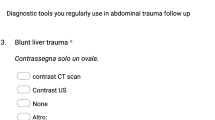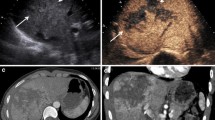Abstract
The objective of this study was to evaluate the concordance of US and contrast-enhanced US (CEUS) with CT in the assessment of solid organ injury following blunt trauma. Patients underwent complete US examination, including free fluid search and solid organ analysis. CEUS followed, using low-mechanical index techniques and SonoVue. CT was performed within 1 h. Among 156 enrolled patients, 91 had one or more abnormalities (n = 107) at CT: 26 renal, 38 liver, 43 spleen. Sensitivity, specificity, and accuracy for renal trauma at baseline US were 36%, 98%, and 88%, respectively, after CEUS values increased to 69%, 99%, and 94%. For liver baseline US values were 68%, 97%, and 90%; after CEUS were 84%, 99%, and 96%. For spleen, results were 77%, 96%, and 91% at baseline US and 93%, 99%, and 97% after CEUS. Per patient evaluation gave the following results in terms of sensitivity, specificity and accuracy: 79%, 82%, 80% at baseline US; 94%, 89%, and 92% following CEUS. CEUS is more sensitive than US in the detection of solid organ injury, potentially reducing the need for further imaging. False negatives from CEUS are due to minor injuries, without relevant consequences for patient management and prognosis.





Similar content being viewed by others
References
Scaglione M (2004) The use of sonography versus computed tomography in the triage of blunt abdominal trauma: the European perspective. Emerg Radiol 10:296–298
Shih H-C, Wen Y-S, Ko T-J, et al. (1999) Noninvasive evaluation of blunt abdominal trauma: prospective study using diagnostic algorithms to minimize nontherapeutic laparotomy. World J Surg 23:265–270
Dolich MO, McKenney MG, Varela JE, et al. (2001) 2,576 ultrasounds for blunt abdominal trauma. J Trauma 50:108–112
McKenney KL, Nunez DB, McKenney MG, et al. (1998) Sonography as primary screening technique for blunt abdominal trauma: experience with 899 patients. AJR 170:979–985
Rothlin MA, Naef R, Amgwerd M, et al. (1993) Ultrasound in blunt abdominal and thoracic trauma. J Trauma 34:488–495
Bokor D, Chambers JB, Rees PJ, et al. (2001) Clinical safety of SonoVue, a new contrast agent for ultrasound imaging, in healthy volunteers and in patients with chronic obstructive pulmonary disease. Invest Radiol 36:104–109
Morel DR, Schwieger I, Hohn L, et al. (2000) Human pharmacokinetics and safety evaluation of SonoVueTM, a new contrast agent for ultrasound imaging. Invest Radiol 35:80–85
Brown MA, Casola G, Sirlin CB, et al. (2001) Blunt abdominal trauma: screening US in 2,693 patients. Radiology 218:352–358
Richards JR, Knopf NA, Wang L, et al. (2002) Blunt abdominal trauma in children: evaluation with emergency US. Radiology 222:749–754
Sirlin CB, Brown MA, Andrade-Barreto OA, et al. (2004) Blunt abdominal trauma: clinical value of negative screening US scans. Radiology 230:661–668
Tas F, Ceran C, Atalar MH, et al. (2004) The efficacy of ultrasonography in hemodynamically stable children with blunt abdominal trauma: a prospective comparison with computed tomography. Eur J Radiol 51:91–96
Lingawi SS, Buckley AR (2000) Focused abdominal US in patients with trauma. Radiology 217:426–429
Emery KH, McAneney CM, Racadio JM, et al. (2001) Absent peritoneal fluid on screening trauma ultrasonography in children: a prospective comparison with computed tomography. J Pediatr Surg 36:565–569
Poletti P-A, Kinkel K, Vermeulen B, et al. (2003) Blunt abdominal trauma: should US be used to detect both free fluid and organ injuries? Radiology 227:95–103
Poletti P-A, Wintermark M, Schnyder P, et al. (2002) Traumatic injuries: role of imaging in the management of polytrauma victim (conservative expectation). Eur Radiol 12:969–978
Taylor GA, Sivit CJ (1995) Posttraumatic peritoneal fluid: is it a reliable indicator of intraabdominal injury in children? J Pediatr Surg 30:1644–1648
Thorelius L (2004) Contrast-enhanced ultrasound in trauma. Eur Radiol 14 (suppl 8): P43–P52
Thorelius L (2003) Contrast-enhanced ultrasound: beyond the liver. Eur Radiol 13:N91–N108
Chiu WC, Cushing BM, Rodriguez A, et al. (1997) Abdominal injuries without hemoperitoneum: a potential limitation of focused abdominal sonography for trauma (FAST). J Trauma 42:617–623
Shanmuganathan K, Mirvis SE, Sherbourne CD, et al. (1999) Hemoperitoneum as the sole indicator of abdominal visceral injuries: a potential limitation for screening abdominal US for trauma. Radiology 212:423–430
Ochsner MG, Knudson MM, Pachter HL, et al. (2000) Significance of minimal or no intraperitoneal fluid visible on CT scan associated with blunt liver and splenic injuries: a multicenter analysis. J Trauma 49:505–510
Yoshii H, Sato M, Yamamoto S, et al. (1998) Usefulness and limitations of ultrasonography in the initial evaluation of blunt abdominal trauma. J Trauma 45:45–51
Poletti PA, Mirvis SE, Shanmuganathan K, et al. (2000) CT criteria for management of blunt liver trauma: correlation with angiographic and surgical findings. Radiology 216:418–427
Stengel D, Bauwens K, Sehouli J et al. (2001) Discriminatory power of 3.5 MHz convex and 7.5 MHz linear ultrasound probes for the imaging of traumatic splenic lesions: a feasibility study. J Trauma 51:37–43
Schiemann U (2004) Ultrasound in emergency patients: better detection of free intraabdominal fluids by use of tissue harmonic imaging. Eur J Med Res 30:328–332
Blaivas M, DeBehnke D, Sierzenski PR, et al. (2002) Tissue harmonic imaging improves organ visualization in trauma ultrasound when compared to standard ultrasound mode. Acad Emerg Med 9:48–53
Nilsson A, Loren I, Nirhov N, et al. (1999) Power Doppler ultrasonography: alternative to computed tomography in abdominal trauma patients. J Ultrasound Med 18:669–672
Catalano O, Lobianco R, Sandomenico F, et al. (2003) Splenic trauma: evaluation with contrast-specific sonography and a second-generation contrast medium: preliminary experience. J Ultrasound Med 22:467–477
Catalano O, Lobianco R, Mattace Raso M, et al. (2005) Blunt hepatic trauma: evaluation with contrast-enhanced sonography. J Ultrasound Med 24:299–310
Oldenburg A, Hohmann J, Skrok J, et al. (2004) Imaging of paediatric splenic injury with contrast-enhanced ultrasonography. Pediatr Radiol 34:351–354
Blaivas M, Lyon M, Brannam L, et al. (2005) Feasibility of FAST examination performance with ultrasound contrast. J Emerg Med 29:307–311
Yao DC, Jeffrey RB, Mirvis SE, et al. (2002) Using contrast-enhanced helical CT to visualize arterial extravasation after blunt abdominal trauma. AJR 178:17–20
Fang JF, Chen RJ, Wong YC, et al. (2000) Classification and treatment of pooling of contrast material computed tomographic scan of blunt hepatic trauma. J Trauma 49:1083–1088
Willmann JK, Roos JE, Platz A, et al. (2002) Multidetector CT: detection of active hemorrhage in patients with blunt abdominal trauma. AJR 179:437–444
Goldberg BB, Merton DA, Liu J-B, et al. (1998) Evaluation of bleeding sites with a tissue-specific sonographic contrast agent: preliminary experiences in an animal model. J Ultrasound Med 17:609–616
Liu J-B, Merton DA, Goldberg BB, et al. (2000) Contrast-enhanced two- and three-dimensional sonography for evaluation of intra-abdominal hemorrhage. J Ultrasound Med 21:161–169
Poletti PA, Platon A, Becker CD, et al. (2004) Blunt abdominal trauma: does the use of a second-generation sonographic contrast agent help to detect solid organ injuries? AJR 183:1293–1301
Catalano O, Cusati B, Nunziata A, et al. (2006) Active abdominal bleeding: contrast-enhanced sonography. Abdom Imaging 31:9–16
Albrecht T, Blomley M, Bolondi L, et al. (2004) Guidelines for the use of contrast agents in ultrasound—January 2004. Ultraschall Med 25:249–256
Goan YG, Huang MS, Lin JM (1998) Nonoperative management for extensive hepatic and splenic injuries with significant hemoperitoneum in adults. J Trauma 45:360–364
Pachter HL, Knudson MM, Esrig B, et al. (1996) Status of nonoperative management of blunt hepatic injuries in 1995: a multicenter experience with 404 patients. J Trauma 40:31–38
Parks RW, Chrysos R, Diamond T (1999) Management of liver trauma. Br J Surg 86:1121–1135
Navarro O, Babyn PS, Pearl RH (2000) The value of routine follow-up imaging in pediatric blunt liver trauma. Pediatr Radiol 30:546–550
Cuff RF, Cogbill TH, Lambert PJ (2000) Nonoperative management of blunt liver trauma: the value of follow-up abdominal computed tomography scans. Am Surg 66:332–336
Mizzi A, Shabani A, Watt A (2002) The role of follow-up imaging in paediatric blunt abdominal trauma. Clin Radiol 57:908–912
Miele V, Buffa V, Stassolla A, et al. (2004) Contrast enhanced ultrasound with second generation contrast agent in traumatic liver lesions. Radiol Med 107:82–91
Kim JH, Eun HW, Lee HK, et al. (2003) Renal perfusion abnormality. Coded harmonic angio US with contrast agent. Acta Radiol 44:166–171
Acknowledgment
Authors are in debt with Massimo Di Maio, M.D., for providing statistical analysis.
Author information
Authors and Affiliations
Corresponding author
Rights and permissions
About this article
Cite this article
Catalano, O., Aiani, L., Barozzi, L. et al. CEUS in abdominal trauma: multi-center study. Abdom Imaging 34, 225–234 (2009). https://doi.org/10.1007/s00261-008-9452-0
Published:
Issue Date:
DOI: https://doi.org/10.1007/s00261-008-9452-0




